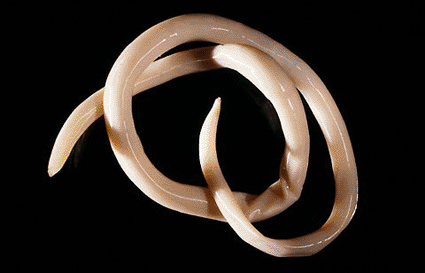Steroid-Like Hormone Prompts Change of Morphology in Parasitic Nematodes
By LabMedica International staff writers
Posted on 09 Jun 2009
Researchers have identified a chemical compound that causes parasitic nematode worms to morph prematurely into the stage requiring feeding from host tissue, which results in the worms starving to death before they can establish an infection.Posted on 09 Jun 2009
According to the World Health Organization (Geneva, Switzerland), parasitic nematodes infect about two billion people worldwide and severely sicken some 300 million, at least 50% being school-age children.

Image: An adult female parasitic nematode worm (Ascaris lumbricoides), a worm that inhabits the human intestine (Photo courtesy of CNRI / SPL).
Investigators from the University of Texas Southwestern Medical Center (Dallas, USA) worked with the free-living worm Caenorhabditis elegans as well as with the parasitic nematode Strongyloides stercoralis. Following up on previous studies showing that the steroid-like hormone dafachronic acid prompted worm larvae to mature from the stage in which they infect a host to the stage in which they start feeding on the host, the investigators sought to establish the molecular mechanism basis for this effect.
The researchers reported in the June 2, 2009, online edition of the journal Proceedings of the [U.S.] National Academy of Sciences (PNAS) that they used X-ray crystallography to solve the three-dimensional structure of the S. stercoralis nuclear receptor DAF-12 ligand-binding domain cocrystallized with dafachronic acids. This data revealed the molecular basis for DAF-12 ligand binding and identified nuclear receptors as unique therapeutic targets in parasitic nematodes.
The next step is to screen large libraries of chemicals to search for compounds that behave like dafachronic acid and that could possibly be developed into pesticides that could be spread in high-infection areas.
"What keeps these parasites infectious is the lack of production of dafachronic acid,” said senior author Dr. David Mangelsdorf, professor of pharmacology at the University of Texas Southwestern Medical Center. "Once they get inside the host, however, something switches them on to begin making this compound. We can interrupt the worm's life cycle just by giving it this compound when it is in the infectious state, before it enters a host.”
Related Links:
World Health Organization
University of Texas Southwestern Medical Center













